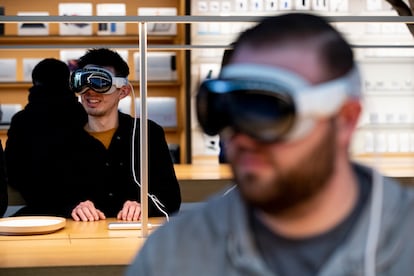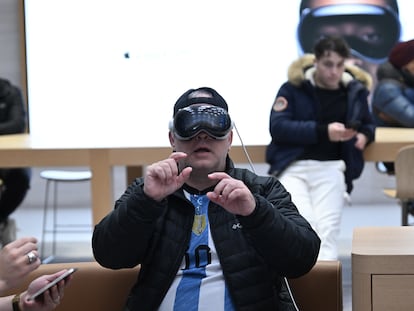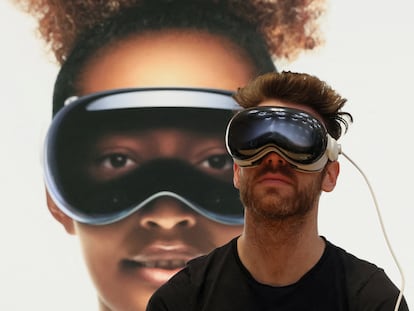Virtual reality headsets: disruptive technology or perpetual meme?
Last month, Apple launched one of its most secret and eagerly awaited products. At over $3,500, the Apple Vision Pro has garnered both praise and criticism, especially for its design

“Are we going extinct as a species?” is the question posed by a user on X, inspired by a video in which a person wearing an Apple Vision Pro headset can be seen using a crosswalk. This is one of hundreds of expressions of disbelief in recent weeks at the images of early adopters of Apple’s secret and long-awaited technological device. Many consider that these headsets, with a price tag over $3,500, are leading the way to a new way of life in augmented reality. However, history has shown that, on many occasions, technical progress is not enough for an invention to be completely accepted and used by society.
“The notion prevails that, once new technologies have been invented, they burst in and begin to directly influence society. However, reality is more complex,” warns Eduard Aibar, author of The cult of innovation. The author gives the example of the printing press. “Although the invention was already known in Korea and China before it was introduced to Europe, it did not have the revolutionary impact on the transmission of knowledge and information that Gutenberg’s version did in the 15th century,” he tells EL PAÍS by phone.
Similarly, steam engines, which come from Hero of Alexandria’s 1st-century aeolipile — a machine made up of an air chamber and tubes through which steam is expelled — existed in primitive forms long before their paradigm-shifting impact during the Industrial Revolution. It was not until the innovations of Thomas Newcomen in the early 18th century and the improvements of James Watt in the 1760s that these machines began to reshape the global economy and society.
Is it just me, or does anyone else find it odd how people look while wearing the Apple Vision Pro? pic.twitter.com/wMv5xdFdZi
— Sylverconsult💜 (@sylverconsult) February 23, 2024
Aibar maintains that “technology by itself means nothing.” According to the expert, the success of any technological invention does not depend solely on technical knowledge, but also on other external factors. He draws on an old slogan used by Spain’s national airline, “Iberia flies to New York,” to further his argument. Although at first glance it seems that it is the plane that flies and not Iberia, science philosophers often interpret it in the opposite way. In fact, the true metaphor is the plane, and it is Iberia that “flies” in a figurative sense. The author assures that the airplane, despite being an essential technology for flight, would lose much of its value without a series of elements and processes that go beyond the technology itself, such as a ticket purchasing system, airport infrastructure, qualified personnel, and maintenance systems, all of which are factors that transcend the technical possibility of a machine weighing hundreds of tons being able to stay in the air.
The Google glasses disaster
Apple CEO Tim Cook stated in June 2023 that the new Vision Pro headsets are “a revolutionary product.” Their objective is to break the curse associated with augmented reality devices, which have not managed to become a successful product over the last decade. In 2015, after a notable failure, Google retired its Google Glass. Objectively speaking, it was an innovative technology that allowed us to do things that had never been seen before. But the rejection was so explicit that the term “Glass-hole” became popular (a portmanteau of glasses and asshole) to describe the people who walked down the street wearing the contraption.
In terms of sales, no augmented reality company has managed to become profitable. Between 2020 and 2024, the Meta division that manages Virtual Reality lost $42 billion. To get an idea of how fragile the situation is, just think that after presenting the accounts for the last quarter of 2023, the Meta board was genuinely happy to have “only” lost $4.5 billion in that division.
We integrated the #AppleVisionPro into our daily life and workflow, using it on the street and in the office. 🚀 pic.twitter.com/AuDhx6EWIY
— AppNation (@appnationco) March 1, 2024
Technology, in and of itself, is not enough, and one of the unavoidable requirements that it must meet is having an aesthetically pleasing design. This was the reason why Ray-Ban, in collaboration with Facebook (now Meta), launched Ray-Ban Stories two years ago. They are smart glasses that allow you to take photos and record videos, in addition to offering some augmented reality functionalities. Although the Ray-Ban Stories do not match the advanced technology of Apple’s Vision Pro, Mark Zuckerberg’s goal with this product was to offer a device that was both aesthetic and discreet.
The problem was that this discretion opened a debate about potential privacy issues, since it allows users to record and take photos unnoticed. Although some measures have been introduced, such as an LED to indicate that the camera is in use, questions remain about its effectiveness in alerting the people around the user.
The science philosopher Fernando Broncano affirms that the process by which a society adopts a new technology is always gradual and complex. “It is often believed that the announcement in the newspapers about the development of a new technology implies that that innovation will be integrated into our lives in a linear and disruptive way. Causing an instant revolution. But it doesn’t work like that. For an innovation to really impact society, there are multiple determining factors that are as central as they are random,” he explains to EL PAÍS. Among these factors, he highlights the availability of a technical environment. That is, an innovation needs a technological ecosystem that supports it in order to exist and adapt. “Why isn’t the metaverse working? Because it needs technologies that are yet to be invented, including augmented reality. Meta has gambled on technologies that are not yet out of the prototype phase being developed in parallel.”
Public, use and ethics
Broncano points out that for a technological innovation to be successful and effectively integrated into the social fabric, it also needs to find an audience and a use. “Most inventions are not used for what their creators had intended them for. For an innovation to survive and thrive, it must create its own audience and adapt to the social environment.”
The philosopher also addresses the importance of risk capital in the development and adoption of technological innovations. Innovations need a significant initial financial investment that often does not generate immediate returns. Examples such as Airbnb, Tesla, and Uber illustrate how these companies incurred financial losses for extended periods before beginning to generate substantial profits. “This is possible thanks to the creation of an ‘imaginary bubble’ through intensive publicity systems, which attract even more venture capital investment despite the inherent risks.”
Jorge Barrero, general director of the Cotec Foundation, focuses on the ethical component that influences whether a technology permeates society. The debate surrounding robot technology designed to collect marine litter and combat the pollution of the ocean is a prime example. In addition to pointing out the technical complexities inherent in the development of such technology, Barrero invites us to reflect on whether it is prudent to focus on this solution instead of prioritizing waste reduction. “Do we really want to fill the seas with robots so we can continue destroying the planet as we please?”
At the same time, Barrero expresses concern about the concentration of power and influence in a technological and social future, where everything is left in the hands of a small group of extremely rich and powerful individuals. “There is no doubt that many of them are visionaries, but this model for the future of mankind being based on the vision of four or five billionaires makes me very uneasy,” he says by phone.
Two weeks ago, the famous YouTuber El Rubius faced a new challenge on his channel. He would wear an Apple Vision Pro headset for 24 hours, thus spending a whole day living in augmented reality. In the end, the challenge did not trigger any extraordinary events. When night came, El Rubius got into bed, selected lake mode— which made a digital body of water appear in front of him — and put on the movie X-Men. “I was so comfortable that I fell asleep almost instantly,” he explained the next morning. “But I think my brain subconsciously made me take my headset off at night, because it was on the other side of the bed when I woke up.” Before finishing the video, he told the audience his conclusions about the new device: “We are approaching that point where technology is almost there. In 10 years, when they are the size of a pair of Ray Bans, everyone will be wearing them.”
Sign up for our weekly newsletter to get more English-language news coverage from EL PAÍS USA Edition
Tu suscripción se está usando en otro dispositivo
¿Quieres añadir otro usuario a tu suscripción?
Si continúas leyendo en este dispositivo, no se podrá leer en el otro.
FlechaTu suscripción se está usando en otro dispositivo y solo puedes acceder a EL PAÍS desde un dispositivo a la vez.
Si quieres compartir tu cuenta, cambia tu suscripción a la modalidad Premium, así podrás añadir otro usuario. Cada uno accederá con su propia cuenta de email, lo que os permitirá personalizar vuestra experiencia en EL PAÍS.
¿Tienes una suscripción de empresa? Accede aquí para contratar más cuentas.
En el caso de no saber quién está usando tu cuenta, te recomendamos cambiar tu contraseña aquí.
Si decides continuar compartiendo tu cuenta, este mensaje se mostrará en tu dispositivo y en el de la otra persona que está usando tu cuenta de forma indefinida, afectando a tu experiencia de lectura. Puedes consultar aquí los términos y condiciones de la suscripción digital.
More information
Archived In
Últimas noticias
Most viewed
- Sinaloa Cartel war is taking its toll on Los Chapitos
- Oona Chaplin: ‘I told James Cameron that I was living in a treehouse and starting a permaculture project with a friend’
- Reinhard Genzel, Nobel laureate in physics: ‘One-minute videos will never give you the truth’
- Why the price of coffee has skyrocketed: from Brazilian plantations to specialty coffee houses
- Silver prices are going crazy: This is what’s fueling the rally











































